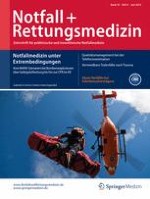01.06.2015 | Originalien
Qualitätsmanagement bei der Telefonreanimation − mehr Daten für mehr Überlebende
Konsentierung eines Zusatzmoduls zum Deutschen Reanimationsregister®
Erschienen in: Notfall + Rettungsmedizin | Ausgabe 4/2015
Einloggen, um Zugang zu erhaltenZusammenfassung
Einführung
Der Erfolg außerklinischer Reanimationen beruht in erster Linie auf dem schnellen Beginn von Basismaßnahmen durch Ersthelfer. Ein Konzept zur Erhöhung des Ersthelferanteils ist die Anleitung des Anrufers durch einen Disponenten der Leitstelle, die sog. „Telefonreanimation“ (T-CPR). Die flächendeckende Einführung der T-CPR ist eine der Kernforderungen der ILCOR-Leitlinien 2010. Ziel des in diesem Beitrag beschriebenen Verfahrens war es, durch Konsentierung von Qualitätsindikatoren die Grundlagen für ein strukturiertes Qualitätsmanagement bei der T-CPR zu schaffen.
Material und Methoden
Die Validierung erfolgte mittels eines vierstufigen Delphi-Verfahrens, an dem sich 6 Experten aus dem Gebiet der Versorgungsforschung in Rettungsleitstellen beteiligten. Während der ersten 3 Stufen waren jeweils 12 von 53 Variablen, und in der 4. Stufe 10 aus 38 Variablen auszuwählen. Das Verfahren wurde im E-Mail-Verfahren durch den korrespondierenden Autoren gesteuert.
Ergebnisse
Der Konsens zu den 10 Variablen (z. B. Patientenalter; Länge des Anrufs; Hinderungsgründe bei der TCPR; Verwendung einer schriftlichen Anleitung; Anleitung zur Beatmung) wurde mit einem Übereinstimmungsindex von 0,941 erreicht; ein Wert von 1,0 entspricht einer vollständigen Übereinstimmung.
Diskussion
Der Delphi-Prozess ergab eine hohe Übereinstimmung zwischen den Experten. Die Implementierung des Datensatzes wird Schlüsse über die wesentlichen Erfolgsfaktoren bei der TCPR zulassen. Davon ausgehend kann das Konzept mit dem Ziel weiterentwickelt werden, noch mehr Leben zu retten.
Anzeige















